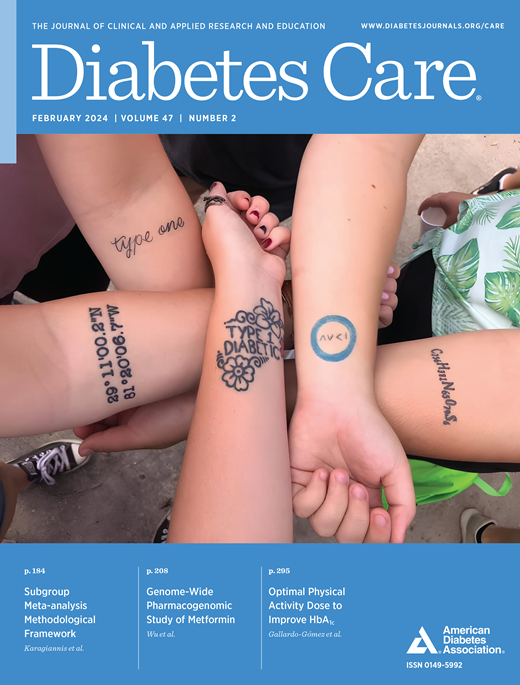Benefit of Semaglutide in Symptomatic Peripheral Artery Disease by Baseline Type 2 Diabetes Characteristics: Insights From STRIDE, a Randomized, Placebo-Controlled, Double-Blind Trial
IF 16.6
1区 医学
Q1 ENDOCRINOLOGY & METABOLISM
引用次数: 0
Abstract
OBJECTIVE The Semaglutide and Walking Capacity in People with Symptomatic Peripheral Artery Disease and Type 2 Diabetes (STRIDE) trial (NCT04560998) showed that once-weekly subcutaneous semaglutide 1.0 mg significantly improved functional outcomes, symptoms, and quality of life in individuals with symptomatic peripheral artery disease (PAD) and type 2 diabetes. Whether these benefits are consistent across diabetes-related characteristics remains unclear. RESEARCH DESIGN AND METHODS The primary outcome was the ratio to baseline (ETR) in maximum walking distance (MWD), with pain-free walking distance (PFWD) as a key secondary end point. Both were measured at 52 weeks using a constant load treadmill. Subgroup analyses were performed by diabetes duration, BMI, HbA1c, and diabetes medications. A mixed model for repeated measurements was used, incorporating treatment, region, and subgroup as fixed factors, and baseline value as covariate, along with the treatment-by-subgroup interaction. RESULTS Among 792 participants (median diabetes duration 12.2 years, HbA1c 7.1%, and BMI 28.7 kg/m2), 35.1% used sodium–glucose cotransporter 2 inhibitors and 31.7% used insulin. Semaglutide significantly improved MWD regardless of diabetes duration (ETR of 1.15 vs. 1.13 for <10 vs. ≥10 years, P = 0.80), BMI (1.12 vs. 1.16 for <30 vs. ≥30 kg/m2, P = 0.58), HbA1c (1.13 for <7% and ≥7%, P = 0.99), or medication use. Semaglutide also improved PFWD across subgroups (P > 0.1 for all interactions). BMI reduction correlated weakly with MWD improvements and was more pronounced in the controls with higher baseline BMI. Safety outcomes were consistent across subgroups. CONCLUSIONS Semaglutide improved walking function in people with PAD and type 2 diabetes, including nonobese individuals and those with well-controlled HbA1c. Benefits were consistent across BMI and HbA1c categories, supporting effectiveness beyond weight or glycemic changes.根据2型糖尿病的基线特征,西马鲁肽对症状性外周动脉疾病的益处:来自STRIDE的见解,一项随机、安慰剂对照、双盲试验
目的:有症状的外周动脉疾病和2型糖尿病患者的塞马鲁肽和行走能力(STRIDE)试验(NCT04560998)显示,每周一次皮下注射塞马鲁肽1.0 mg可显著改善有症状的外周动脉疾病(PAD)和2型糖尿病患者的功能结局、症状和生活质量。这些益处在糖尿病相关特征中是否一致仍不清楚。研究设计和方法主要终点是最大步行距离(MWD)与基线的比值(ETR),无痛步行距离(PFWD)作为关键的次要终点。在52周时使用恒定负荷跑步机进行测量。根据糖尿病病程、BMI、HbA1c和糖尿病药物进行亚组分析。使用重复测量的混合模型,将治疗、地区和亚组作为固定因素,基线值作为协变量,以及治疗与亚组之间的相互作用。结果:在792名参与者中(糖尿病病程中位数为12.2年,HbA1c为7.1%,BMI为28.7 kg/m2), 35.1%使用钠-葡萄糖共转运蛋白2抑制剂,31.7%使用胰岛素。无论糖尿病病程(ETR为1.15 vs. 1.13, 10年vs.≥10年,P = 0.80)、BMI(30年vs.≥30 kg/m2, ETR为1.12 vs. 1.16, P = 0.58)、HbA1c(7%和≥7%,P = 0.99)或用药情况如何,Semaglutide均显著改善了MWD。Semaglutide还改善了各亚组的PFWD (P >;0.1表示所有交互)。BMI降低与MWD改善的相关性较弱,在基线BMI较高的对照组中更为明显。各亚组的安全性结果一致。结论:Semaglutide改善了PAD和2型糖尿病患者的行走功能,包括非肥胖个体和HbA1c控制良好的患者。在BMI和HbA1c类别中,益处是一致的,支持了体重或血糖变化之外的有效性。
本文章由计算机程序翻译,如有差异,请以英文原文为准。
求助全文
约1分钟内获得全文
求助全文
来源期刊

Diabetes Care
医学-内分泌学与代谢
CiteScore
27.80
自引率
4.90%
发文量
449
审稿时长
1 months
期刊介绍:
The journal's overarching mission can be captured by the simple word "Care," reflecting its commitment to enhancing patient well-being. Diabetes Care aims to support better patient care by addressing the comprehensive needs of healthcare professionals dedicated to managing diabetes.
Diabetes Care serves as a valuable resource for healthcare practitioners, aiming to advance knowledge, foster research, and improve diabetes management. The journal publishes original research across various categories, including Clinical Care, Education, Nutrition, Psychosocial Research, Epidemiology, Health Services Research, Emerging Treatments and Technologies, Pathophysiology, Complications, and Cardiovascular and Metabolic Risk. Additionally, Diabetes Care features ADA statements, consensus reports, review articles, letters to the editor, and health/medical news, appealing to a diverse audience of physicians, researchers, psychologists, educators, and other healthcare professionals.
 求助内容:
求助内容: 应助结果提醒方式:
应助结果提醒方式:


